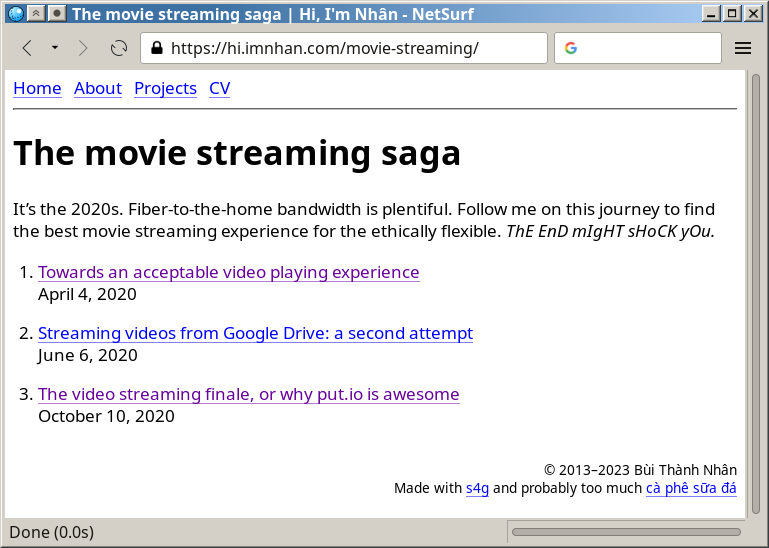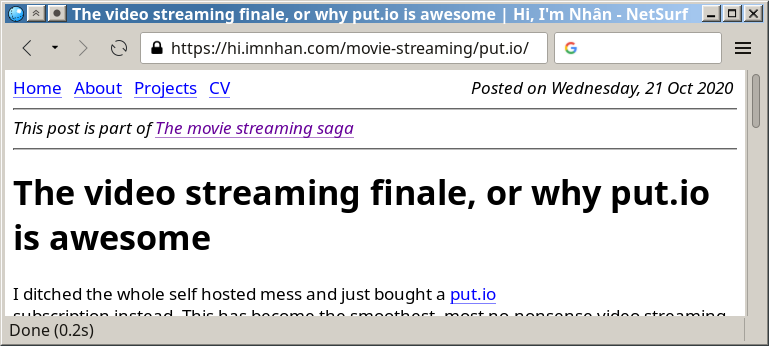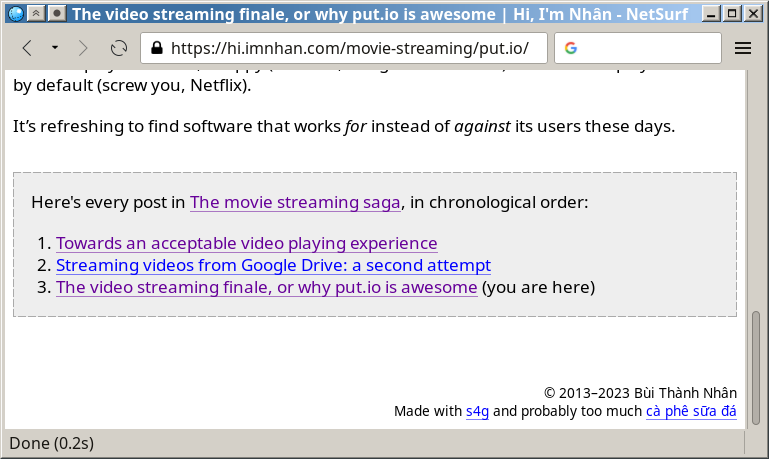s4g is a Stupidly Simple Static Site Generator
This blog is now built with s4g—an experimental static site generator.
Why?#
Unlike typical static site generators, s4g doesn’t separate source code and output. For a concrete example, Pelican would read source from the /content/ dir and write a complete website to /output/, like this:
my-blog
├── content <-- source
│ ├── pages
│ │ ├── about.md
│ │ └── home.md
│ └── posts
│ ├── first-post.md
│ └── second-post.md
└── output <-- generated website ready to be served
├── about
│ └── index.html
├── home
│ └── index.html
└── posts
├── first-post
│ └── index.html
└── second-post
└── index.html
s4g, on the other hand, simply looks for .dj files (s4g uses djot instead of markdown) and generates a matching .html in the same place:
my-blog <-- is both source and serveable website
├── about
│ ├── index.dj
│ └── index.html
├── home
│ ├── index.dj
│ └── index.html
└── posts
├── first-post
│ index.dj
│ index.html
└── second-post
├── index.dj
└── index.html
This is certainly not a novel idea. In fact, one can glob over their dir with a pandoc command and be done with it. The fun starts when you want to generate things that need aggregate data, a home index, series index, RSS feed, etc… While we’re at it, why not add rebuild-on-save, livereload, the whole shebang? One thing led to another, and s4g was born.
This dumb approach to paths simplifies a few things:
1. Folder layout is website layout#
With Pelican we typically need to supply a few url patterns to let the generator know where to put the generated html:
ARTICLE_PATHS = ["posts"]
ARTICLE_URL = "posts/{slug}/"
ARTICLE_SAVE_AS = "posts/{slug}/index.html"
ARTICLE_LANG_URL = "posts/{slug}-{lang}/"
ARTICLE_LANG_SAVE_AS = "posts/{slug}-{lang}/index.html"
While with s4g we just put the .dj file where we want the .html to end up.
2. Obvious static asset placement#
A post typically links to static assets such as images or videos. Ideally we want to put these assets in the same place as their content file. This is surprisingly tricky with Pelican: we have to either throw every asset of every post in one big static folder, or carefully tweak the url settings and use a custom link syntax, as per their docs:
Note: Placing static and content source files together in the same source directory does not guarantee that they will end up in the same place in the generated site. The easiest way to do this is by using the
{attach}link syntax (described below). Alternatively, theSTATIC_SAVE_AS,PAGE_SAVE_AS, andARTICLE_SAVE_ASsettings (and the corresponding*_URLsettings) can be configured to place files of different types together, just as they could in earlier versions of Pelican.
With s4g, we can simply put asset files in the same folder as the index.dj
file, and use relative links when referencing them in the djot body.
Here’s an example from my blog:
# a post's folder structure:
sqlite-python/
├── byte_databases.jpg <-- asset
├── index.dj <-- source
└── index.html <-- generated html
# in index.dj, to generate an img tag:

No custom url syntax needed, and any djot previewer will have no problem picking up the image (assuming djot gets popular enough to get previewer support in the first place).
3. Easy post grouping#
Sometimes I write a series of related posts, and want to make it obvious when a visitor lands on any such post. The s4g solution: put them all in a folder. Here’s a live example from my blog:
movie-streaming/ <-- series home
├── gflick <-- post
│ ├── index.dj
│ └── index.html
├── gflick-fixed <-- post
│ ├── gflick_01_mobile.png
│ ├── index.dj
│ └── index.html
├── index.dj
├── index.html
└── put.io <-- post
├── index.dj
├── index.html
└── put.io-drag-n-drop.mp4
Here’s the content of /movie-streaming/index.dj:
Title: The movie streaming saga
ShowInFeed: false
PageType: series-index
---
It's the 2020s. Fiber-to-the-home bandwidth is plentiful.
Follow me on this journey to find the best movie streaming experience for the
ethically flexible. _ThE EnD mIgHT sHoCK yOu._
When s4g finds a .dj with PageType: series-index, it treats the page as a
series index, and its direct subfolders as posts in this series.
The series index renders its list of posts in addition to its own djot content:

Each post in the series has a extra header and footer:


Miscellaneous blog things#
An RSS feed is table stakes, so that’s what we get out of the box. Technically it’s an Atom feed, but hey, tomaytoes-tomahtoes.
There’s also automatic OpenGraph / Twitter Cards meta tags, so we get those sweet preview widgets when sharing links on social media or rich chat applications.
Cool links don’t die, but sometimes we do want to change a post’s URL. In such cases, simply add a line to _s4g/redirects.txt that says:
old-link/index.html -> new-link/
S4g will then generate old-link/index.html with the appropriate <meta
http-equiv="Refresh" ...> tag to redirect visitors to the new location. I
heard this works on googlebot too! Anyway, this is how I updated all of my old
lengthy paths e.g. “posts/introducing-mcross-a-minimal-gemini-browser” to
short, typeable paths such as “mcross”.
Quality-of-life stuff#
I originally wanted to use s4g as a teaching tool for a sort of “Learning HTML/CSS by creating a blog” tutorial series, but lost interest halfway. It still resulted in a few user-friendly goodies: out-of-the box livereload, a custom human-friendly metadata syntax, error message shown directly on the browser (still incomplete: it includes the offending file and field, but no line number yet), etc.
The livereload turns out to be quite handy: it feels especially nice to edit my css, save and see the change instantly on my phone browser.
Quickstart#
# Install
sudo pacman -Syu nodejs go
go install go.imnhan.com/s4g@latest
# Create first blog
s4g new -f ~/blog
cd ~/blog
s4g # start webserver at localhost:8000 and listen for changes
Visit http://localhost:8000 and you’ll see a blank home page.
To add your first post, create a new hello.dj file:
Title: Hello world
PostedAt: 2023-01-02 19:00
---
Why _hello_ there!
The home page will now auto-refresh, showing your newly minted “hello world”.
For more elaborate examples, check out the sample site and my own blog, which cover hidden posts, deploying on sub-directory paths, custom & fallback thumbnails, per-post custom templates, series, among other things.
Questionables#
Djot?#
Imagine markdown but not full of corner cases and highly extensible. No disrespect to John Gruber here—his thing worked for his purposes—but I think it’s a tragedy that we as an industry failed to converge on a more technically sound format for lightweight text markup.
Since source and output live in the same folder, will some bug in s4g eat my source?#
I obviously try to avoid that, but the current code is proof-of-concept quality. Therefore, I only run s4g on version-controlled websites, and recommend users do the same for now.
Adding compiled assets to version control sounds… bad?#
For programs, probably. For websites though, I prefer to keep snapshots of the whole website as it’s deployed, and be able to roll it back together with the source code. Admittedly this makes for noisy diffs sometimes, but I’ll be sly here and call it a UI problem ;)
I just looked at the code and holy crap what’s with all those (non) data structures and nested loops!#
Yeah but the whole thing takes about 100ms on my thirty-something-articles blog, which is by no means impressive, but not a real hindrance for daily use either. If an actual user shows up with a site big enough to have a problem, I’ll look into optimizing it.